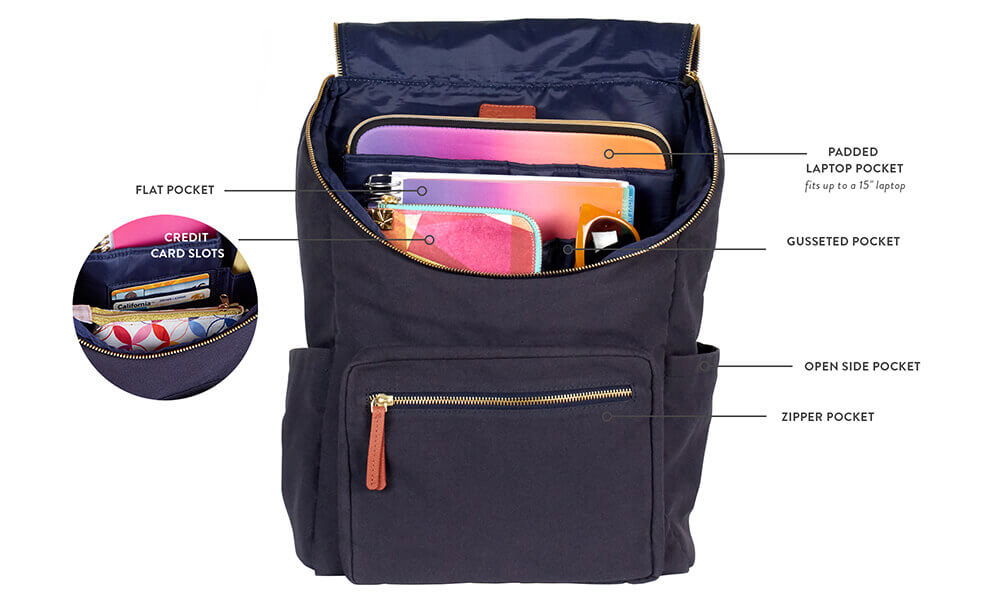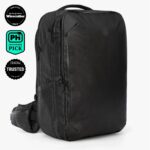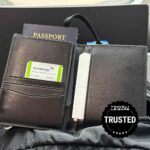Is your backpack a constant mess? Finding what you need quickly can feel impossible when everything is jumbled together.
Imagine opening your bag and instantly spotting your phone, keys, or notebook without digging around. Organizing your backpack isn’t just about neatness—it saves you time, reduces stress, and helps you carry only what you really need. You’ll discover simple, effective tips to transform your backpack into a clutter-free, easy-to-navigate space.
Ready to take control of your bag and make every day smoother? Let’s get started.
Choosing The Right Backpack
Choosing the right backpack is key to staying organized and comfortable. The perfect backpack fits your needs and makes carrying items easy. Consider size, pockets, and material before buying. These factors help keep your stuff safe and easy to find.
Size And Capacity
Pick a backpack size that fits what you carry daily. Too big means extra weight and wasted space. Too small means you might not fit all your things. Think about what you need to bring and choose a size that matches.
Compartments And Pockets
Good backpacks have many compartments and pockets. These help separate items and keep them easy to reach. Look for pockets for water bottles, electronics, and small items. Organization starts with smart pocket design.
Material And Durability
Strong materials make backpacks last longer. Choose water-resistant fabric to protect your items from rain. Check for sturdy zippers and reinforced seams. A tough backpack saves money and stress over time.

Packing Essentials First
Packing essentials first is the key to an organized backpack. It helps you find important items quickly. It also saves space and avoids mess. Start by knowing what you really need. Then place these items carefully inside your bag. This method keeps your backpack neat and easy to use.
List Your Must-haves
Write down the items you cannot forget. Think about what you need every day. Examples include your phone, wallet, keys, and water bottle. This list will guide your packing. It stops you from carrying too much or too little.
Prioritize By Usage
Put the things you use the most in easy reach. Less used items can go deeper inside the bag. For example, pack your notebook or snacks behind your phone or wallet. This way, you won’t have to dig through your backpack often.
Keep Important Items Accessible
Keep your valuables in small pockets or compartments. Items like your ID or cash should be easy to grab. This prevents frustration and saves time. It also keeps your important belongings safe and organized.
Smart Packing Techniques
Packing a backpack efficiently saves space and keeps things tidy. Smart packing techniques help you fit more items without making your bag heavy or messy. These tips make it easy to find what you need quickly.
Use these simple methods to organize your clothes and gear for a smooth trip or daily use.
Roll Vs Fold Clothing
Rolling clothes saves more space than folding. It reduces wrinkles and fits better in small spaces. Roll t-shirts, pants, and light items tightly. Fold heavy or bulky clothes like jackets to keep their shape. Mix rolling and folding for the best use of space.
Use Packing Cubes
Packing cubes divide your backpack into sections. They keep clothes and items separate and organized. Use different cubes for shirts, underwear, and accessories. Cubes make it easy to pull out what you need without unpacking everything. Choose cubes in various sizes to fit your bag perfectly.
Layering For Balance
Place heavy items near your back to balance weight. Put lighter clothes and gear in front and top areas. Layer items by size, starting with the largest at the bottom. This keeps your backpack stable and comfortable to carry. Proper layering prevents items from shifting while walking.
Maximizing Space
Maximizing space in your backpack makes carrying easier and more comfortable. Organizing well helps you fit more items without clutter. It also keeps things easy to find. Use smart methods to use every inch of your backpack efficiently.
Utilize Every Pocket
Backpacks have many pockets of different sizes. Use each one for small items like chargers, keys, or snacks. This keeps your main compartment free for larger things. Pockets help separate items to avoid mess and damage.
Compress Bulky Items
Bulky items take up much space. Use compression bags or straps to flatten clothes and gear. This reduces their size and creates more room. Compressing also prevents items from shifting while you walk.
Fill Small Gaps
Small gaps often go unused. Fill these spaces with socks, cables, or small accessories. These items fit well in tight spaces and keep your backpack balanced. Filling gaps stops your gear from moving around inside.
Weight Distribution Tips
Proper weight distribution makes carrying a backpack easier and safer. It helps reduce back pain and improves balance. Organizing your backpack by weight also protects your gear from damage. Follow these simple tips to keep your load stable and comfortable.
Pack Heavy Items Close To Back
Place heavy items near your back and in the middle of the pack. This keeps the weight centered and reduces strain. Avoid putting heavy things at the bottom or far from your spine. It helps keep your balance and posture straight.
Avoid Overloading One Side
Distribute weight evenly on both sides of the backpack. Do not put all heavy items on one side. Uneven weight causes discomfort and can hurt your back. Balance the load to prevent leaning or twisting while walking.
Adjust Straps For Comfort
Use the shoulder, chest, and waist straps to secure the backpack. Tighten straps so the pack stays close to your body. Loose straps allow the pack to swing, causing fatigue. Adjust straps often to keep a snug, comfortable fit.

Keeping Things Organized
Keeping things organized in your backpack helps you find items quickly. It saves time and reduces stress. A neat backpack also protects your belongings from damage. Small steps make a big difference in staying organized.
Separate By Category
Group similar items together to keep order. For example, put electronics in one section and snacks in another. This separation makes it easier to grab what you need fast. It also prevents items from mixing and causing clutter.
Label Your Bags
Use labels to identify different compartments or bags. Write clear names like “chargers,” “toiletries,” or “stationery.” Labels help you remember where things belong. They keep your backpack tidy and save time searching.
Use Clear Pouches
Choose see-through pouches for storing small items. Clear pouches let you spot contents without opening them. They keep things protected and prevent spills. Using clear pouches keeps your backpack neat and organized.
Safety And Security
Keeping your backpack safe and secure is very important. It protects your important items and gives you peace of mind. Organizing your backpack with safety in mind helps avoid loss or damage. Small steps can make a big difference in protecting your gear.
Protect Valuables
Store valuables like phones, wallets, and keys in inner pockets. Use padded compartments to prevent damage. Keep these items close to your body while traveling. Avoid loose items that can fall out or get stolen.
Use Locks And Zippers
Choose backpacks with strong zippers that close tightly. Use small locks for extra protection on main compartments. Double-check zippers before leaving a place. Locked zippers make it harder for thieves to access your bag.
Waterproof Your Gear
Use waterproof bags or covers for electronics and important papers. Pack items in plastic bags to keep them dry. Select backpacks made with water-resistant materials. This prevents damage from rain or spills during travel.
Maintaining Your Backpack
Keeping your backpack in good shape is key to making it last longer. A well-maintained backpack stays clean and strong, ready for every trip or daily use. Simple care steps help avoid damage and keep it looking fresh.
Regular Cleaning
Empty your backpack before cleaning. Shake out crumbs and dirt from all pockets. Use a soft brush or cloth to wipe off dust. For deeper cleaning, wash with mild soap and water. Let it air dry completely to prevent mold. Avoid harsh chemicals that can harm the fabric.
Check For Wear And Tear
Look over zippers, straps, and seams often. Fix small tears with needle and thread. Replace broken zippers quickly to keep things secure. Tighten loose straps to keep the backpack balanced. Early repairs stop bigger problems later.
Store Properly
Store your backpack in a cool, dry place. Avoid direct sunlight to prevent fading. Keep it empty and open to keep its shape. Use a dust cover or bag to protect it from dirt. Proper storage helps keep your backpack fresh and ready.

Frequently Asked Questions
How Do I Start Organizing My Backpack Effectively?
Begin by emptying your backpack completely. Sort items into categories like books, gadgets, and snacks.
What Are The Best Tips To Keep A Backpack Tidy Daily?
Use small pouches for similar items and put heavy things at the bottom for balance.
How Can I Save Space While Organizing My Backpack?
Roll clothes instead of folding and use packing cubes to compress items neatly.
Which Items Should I Always Keep Accessible In My Backpack?
Keep essentials like your phone, wallet, keys, and a water bottle in easy-to-reach pockets.
How Often Should I Clean And Reorganize My Backpack?
Clean and reorganize your backpack at least once a week to avoid clutter buildup.
Conclusion
Organizing your backpack makes daily life easier and less stressful. Keep things in separate compartments for quick access. Regularly check and remove items you don’t need. A well-arranged backpack saves time and keeps you prepared. Small changes can make a big difference in your routine.
Start organizing today and feel the difference tomorrow. Simple steps lead to better habits and less clutter. Your backpack, neat and ready for any adventure.






